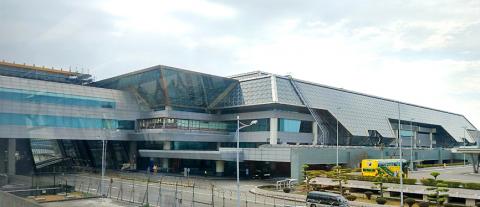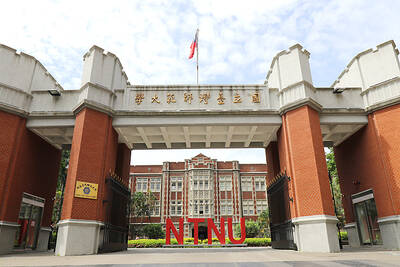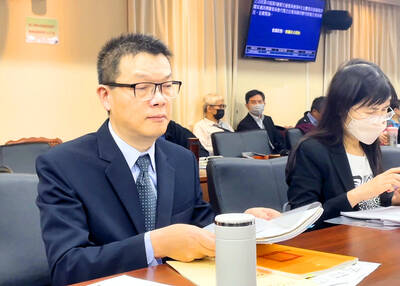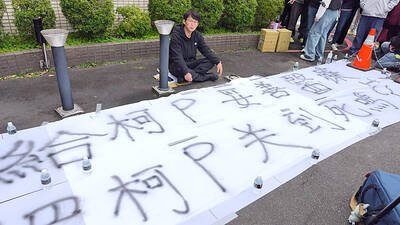Taiwan Taoyuan International Airport’s Terminal 2 is to be closed two years for renovation after the new Terminal 3 comes into service in 2021, Taoyuan International Airport Corp chairman Tseng Dar-jen (曾大仁) said yesterday.
The airport operator decided to overhaul Terminal 2’s aging power and water supply systems to prevent further problems that could affect the terminal’s operations after two power outages at the terminal in 2014 and last year, Tseng said.
The renovation is to focus on replacing electrical wiring, water pipes and the airconditioning system, which is expected to take two years to complete, Tseng said in an interview.

Photo: Tony Yao, Taipei Times.
Terminal 3 is expected to be completed by 2020 and is to be put into operation in 2021 following a six-month trial run, Tseng said.
Because the new terminal will be capable of handling 45 million passengers per year, the period after it opens would be the best time to shut down Terminal 2, Tseng added.
The company has decided to move carriers operating out of Terminal 2 to Terminal 3 at the end of 2021, Tseng said.
Terminal 2 opened in July 2000 with a capacity of 17 million passengers to reduce heavy congestion in Terminal 1, Tseng said.
Due to significant growth in passenger traffic over the past few years, the company in 2015 began a project to expand Terminal 2’s capacity by 5 million passengers per year, with work expected to be completed next year, Tseng said.

CHANGING LANDSCAPE: Many of the part-time programs for educators were no longer needed, as many teachers obtain a graduate degree before joining the workforce, experts said Taiwanese universities this year canceled 86 programs, Ministry of Education data showed, with educators attributing the closures to the nation’s low birthrate as well as shifting trends. Fifty-three of the shuttered programs were part-time postgraduate degree programs, about 62 percent of the total, the most in the past five years, the data showed. National Taiwan Normal University (NTNU) discontinued the most part-time master’s programs, at 16: chemistry, life science, earth science, physics, fine arts, music, special education, health promotion and health education, educational psychology and counseling, education, design, Chinese as a second language, library and information sciences, mechatronics engineering, history, physical education

DEADLOCK: As the commission is unable to forum a quorum to review license renewal applications, the channel operators are not at fault and can air past their license date The National Communications Commission (NCC) yesterday said that the Public Television Service (PTS) and 36 other television and radio broadcasters could continue airing, despite the commission’s inability to meet a quorum to review their license renewal applications. The licenses of PTS and the other channels are set to expire between this month and June. The National Communications Commission Organization Act (國家通訊傳播委員會組織法) stipulates that the commission must meet the mandated quorum of four to hold a valid meeting. The seven-member commission currently has only three commissioners. “We have informed the channel operators of the progress we have made in reviewing their license renewal applications, and

The High Prosecutors’ Office yesterday withdrew an appeal against the acquittal of a former bank manager 22 years after his death, marking Taiwan’s first instance of prosecutors rendering posthumous justice to a wrongfully convicted defendant. Chu Ching-en (諸慶恩) — formerly a manager at the Taipei branch of BNP Paribas — was in 1999 accused by Weng Mao-chung (翁茂鍾), then-president of Chia Her Industrial Co, of forging a request for a fixed deposit of US$10 million by I-Hwa Industrial Co, a subsidiary of Chia Her, which was used as collateral. Chu was ruled not guilty in the first trial, but was found guilty

Taiwan People’s Party (TPP) Chairman Huang Kuo-chang (黃國昌) yesterday appealed to the authorities to release former Taipei mayor Ko Wen-je (柯文哲) from pretrial detention amid conflicting reports about his health. The TPP at a news conference on Thursday said that Ko should be released to a hospital for treatment, adding that he has blood in his urine and had spells of pain and nausea followed by vomiting over the past three months. Hsieh Yen-yau (謝炎堯), a retired professor of internal medicine and Ko’s former teacher, said that Ko’s symptoms aligned with gallstones, kidney inflammation and potentially dangerous heart conditions. Ko, charged with